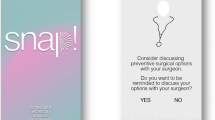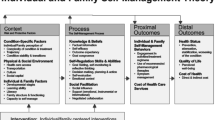Abstract
Women with BRCA mutations, at significantly increased risk for breast and ovarian cancer, do not consistently adhere to management guidelines due to lack of awareness and challenges tracking appointments. We developed an iPhone application (app) to help BRCA carriers manage their surveillance. We explored baseline awareness and adherence to surveillance guidelines and analytic data from 21 months of app use. Descriptive statistics were calculated on responses (N = 86) to a survey about surveillance awareness and practices. The majority were aware of breast surveillance guidelines, but only one third were aware of ovarian surveillance guidelines. In practice, the majority reported a clinical breast exam within 6 months, just over half reported a mammogram and breast MRI in the last year, and under half reported ovarian surveillance in the last year. Nearly 50% reported difficulty remembering appointments. Although only 69 received access codes, 284 unique users attempted to enter the app, which was visible in the iTunes store but only available to those with a study code. Evaluation of analytic data demonstrated user engagement with study participants accessing the app 427 times over the 21-month time period (range 2–57; mean = 6.28). Results indicate participants were more likely to know screening guidelines than practice them. There was interest in the app and users were engaged, suggesting app value. We will send a follow-up survey after 18 months of app use for additional evaluation and feedback.




Similar content being viewed by others
References
Atzinger, C. L., Melvin, A., & Heald, B. (2011). Presented abstracts from the Thirtieth Annual Education Conference of the National Society of Genetic Counselors (San Diego, CA, October 2011). Journal of Genetic Counseling, 20(6), 690–771. https://doi.org/10.1007/s10897-011-9404-7.
Ajzen, I., & Fishbein, M. (1980) Understanding attitudes and predicting social behavior. Englewood Cliffs, NJ: Prentice Hall.
Botkin, J. R., Smith, K. R., Croyle, R. T., Baty, B. J., Wylie, J. E., Dutson, D., …, Lyon, E. (2003). Genetic testing for a BRCA1 mutation: prophylactic surgery and screening behavior in women 2 years post testing. American Journal of Medical Genetics Part A, 118A(3), 201–209. https://doi.org/10.1002/ajmg.a.10102.
Buchanan, A. H., Voils, C. I., Schildkraut, J. M., Fine, C., Horick, N. K., Marcom, P. K., …, Skinner, C. S. (2017). Adherence to recommended risk management among unaffected women with a BRCA mutation. Journal of Genetic Counseling, 26(1), 79–92.
Calderon-Margalit, R., & Paltiel, O. (2004). Prevention of breast cancer in women who carry BRCA1 or BRCA2 mutations: a critical review of the literature. International Journal of Cancer, 112(3), 357–364.
Champion, V. L., & Skinner, C. S. (2003). Differences in perceptions of risk, benefits, and barriers by stage of mammography adoption. Journal of Women's Health, 12(3), 277–286.
Coughlin, S., Thind, H., Liu, B., Champagne, N., Jacobs, M., & Massey, R. I. (2016). Mobile phone apps for preventing cancer through educational and behavioral interventions: state of the art and remaining challenges. JMIR Mhealth Uhealth, 4(2), e69. https://doi.org/10.2196/mhealth.5361.
Daly, M. B., Axilbund, J. E., Buys, S., Crawford, B., Farrell, C. D., Friedman, S., …, Weitzel, J. N. (2010). Genetic/familial high-risk assessment: breast and ovarian. Journal of the National Comprehensive Cancer Network, 8(5), 562–594. https://doi.org/10.6004/jnccn.2010.0043.
Daly, M. B., Axilbund, J. E., Buys, S., Crawford, B., Friedman, S., Garber, J., …, Whelan, A. (2012). NCCN guidelines version 1.2012 genetic/familial high-risk assessment: breast and ovarian. Retrieved from nccn.org.
Daly, M. B., Pilarski, R., Axilbund, J., Buys, S. S., Crawford, B., Farmer, M., & et al. (2014). NCCN guidelines version 2.2014 genetic/familial high-risk assessment: breast and ovarian. NCCN Guidelines.
Daly, M. B., Pilarski, R., Berry, M., Buys, S. S., Farmer, M., Friedman, S., …, Wiesner, G. L. (2017). NCCN guidelines version 2.2017 panel members: genetic/familial high-risk assessment: breast and ovarian (pp. 1540-1405). Retrieved from
Davis, F. D. (1989). Perceived usefulness, perceived ease of use, and user acceptance of information technology. MIS Quarterly, 319–340.
DiMatteo, M. R., Hays, R. D., Gritz, E. R., Bastani, R., Crane, L., Elashoff, R., …, Marcus, A. (1993). Patient adherence to cancer control regimens: scale development and initial validation. Psychological Assessment, 5(1), 102.
Ernsting, C., Dombrowski, S. U., Oedekoven, M., JL, O. S., Kanzler, M., Kuhlmey, A., & Gellert, P. (2017). Using smartphones and health apps to change and manage health behaviors: a population-based survey. Journal of Medical Internet Research, 19(4), e101. https://doi.org/10.2196/jmir.6838.
Euhus, D. (2012). Managing the breast in patients who test positive for hereditary breast cancer. Annals of Surgical Oncology, 19(6), 1738–1744. https://doi.org/10.1245/s10434-012-2258-x.
Free, C., Phillips, G., Watson, L., Galli, L., Felix, L., Edwards, P., …, Haines, A. (2013). The effectiveness of mobile-health technologies to improve health care service delivery processes: a systematic review and meta-analysis. PLoS Medicine, 10(1), e1001363. https://doi.org/10.1371/journal.pmed.1001363.
Grann, V., Patel, P., Jacobson, J., Warner, E., Heitjan, D., Ashby-Thompson, M., …, Neugut, A. (2011). Comparative effectiveness of screening and prevention strategies among <i>BRCA1/2</i>-affected mutation carriers. Breast Cancer Research and Treatment, 125(3), 837–847. https://doi.org/10.1007/s10549-010-1043-4.
Julian-Reynier, C., Mancini, J., Mouret-Fourme, E., Gauthier-Villars, M., Bonadona, V., Berthet, P., …, Nogues, C. (2011). Cancer risk management strategies and perceptions of unaffected women 5 years after predictive genetic testing for BRCA1/2 mutations. European Journal of Human Genetics, 19(5), 500–506.
Kuchenbaecker, K. B., Hopper, J. L., Barnes, D. R., et al. (2017). Risks of breast, ovarian, and contralateral breast cancer for BRCA1 and BRCA2 mutation carriers. JAMA, 317(23), 2402–2416. https://doi.org/10.1001/jama.2017.7112.
Kurian, A. W., Sigal, B. M., & Plevritis, S. K. (2010). Survival analysis of cancer risk reduction strategies for BRCA1/2 mutation carriers. Journal of Clinical Oncology, 28(2), 222–231. https://doi.org/10.1200/JCO.2009.22.7991.
Le-Petross, H. T., Whitman, G. J., Atchley, D. P., Yuan, Y., Gutierrez-Barrera, A., Hortobagyi, G. N., …, Arun, B. K. (2011). Effectiveness of alternating mammography and magnetic resonance imaging for screening women with deleterious BRCA mutations at high risk of breast cancer. Cancer, 117(17), 3900–3907. https://doi.org/10.1002/cncr.25971.
Llort, G., Chirivella, I., Morales, R., Serrano, R., Sanchez, A. B., Teulé, A., …, Grana, B. (2015). SEOM clinical guidelines in hereditary breast and ovarian cancer. Clinical & Translational Oncology, 17, 956.
McKinnon, W., Naud, S., Ashikaga, T., Colletti, R., & Wood, M. (2007). Results of an intervention for individuals and families with BRCA mutations: a model for providing medical updates and psychosocial support following genetic testing. Journal of Genetic Counseling, 16(4), 433–456. https://doi.org/10.1007/s10897-006-9078-8.
Morgan, D., Sylvester, H., Lucas, F. L., & Miesfeldt, S. (2010). Perceptions of high-risk care and barriers to care among women at risk for hereditary breast and ovarian cancer following genetic counseling in the community setting. Journal of Genetic Counseling, 19(1), 44–54. https://doi.org/10.1007/s10897-009-9261-9.
O’Neill, S. C., Valdimarsdottir, H. B., Demarco, T. A., Peshkin, B. N., Graves, K. D., Brown, K., …, Schwartz, M. D. (2010). BRCA1/2 test results impact risk management attitudes, intentions, and uptake. Breast Cancer Research and Treatment. https://doi.org/10.1007/s10549-010-0881-4.
Paluch-Shimon, S., Cardoso, F., Sessa, C., Balmana, J., Cardoso, M., Gilbert, F., & Senkus, E. (2016). Prevention and screening in BRCA mutation carriers and other breast/ovarian hereditary cancer syndromes: ESMO clinical practice guidelines for cancer prevention and screening. Annals of Oncology, 27(suppl_5), v103–v110.
Peshkin, B. N., Schwartz, M. D., Isaacs, C., Hughes, C., Main, D., & Lerman, C. (2002). Utilization of breast cancer screening in a clinically based sample of women after BRCA1/2 testing. Cancer Epidemiology, Biomarkers & Prevention, 11(10), 1115–1118.
Pichert, G., Jacobs, C., Jacobs, I., Menon, U., Manchanda, R., Johnson, M., …, Izatt, L. (2010). Novel one-stop multidisciplinary follow-up clinic significantly improves cancer risk management in BRCA1/2 carriers. Familial Cancer, 9(3), 313–319. https://doi.org/10.1007/s10689-010-9333-x.
Rodriguez, M. C., Ooms, A., Montanez, M., & Yan, Y. L. (2005). Perceptions of online learning quality given comfort with technology, motivation to learn technology skills, satisfaction, and online learning experience. Online Submission.
Schwartz, M. D., Isaacs, C., Graves, K. D., Poggi, E., Peshkin, B. N., Gell, C., …, Perley, L. (2011). Long-term outcomes of BRCA1/BRCA2 testing: risk reduction and surveillance. Cancer, n/a-n/a. https://doi.org/10.1002/cncr.26294.
Tinley, S. T., Houfek, J., Watson, P., Wenzel, L., Clark, M. B., Coughlin, S., & Lynch, H. T. (2004). Screening adherence in BRCA1/2 families is associated with primary physicians' behavior. American Journal of Medical Genetics Part A, 125A(1), 5–11. https://doi.org/10.1002/ajmg.a.20431.
Wainberg, S., & Husted, J. (2004). Utilization of screening and preventive surgery among unaffected carriers of a BRCA1 or BRCA2 gene mutation. Cancer Epidemiology, Biomarkers & Prevention, 13(12), 1989–1995.
Walker, J. L., Powell, C. B., Chen, L. M., Carter, J., Bae Jump, V. L., Parker, L. P., …, Gibb, R. K. (2015). Society of Gynecologic Oncology recommendations for the prevention of ovarian cancer. Cancer, 121(13), 2108–2120.
Acknowledgements
The authors would like to acknowledge the NSGC Cancer SIG for a grant to design a tool for women with a BRCA mutation and the St. Vincent Foundation for a grant toward the development of the SNAP for BRCA iPhone app. We also appreciate the women with a BRCA mutation who participated in this study.
Author information
Authors and Affiliations
Corresponding author
Ethics declarations
Conflict of Interest
Authors Stephanie Cohen, Courtney Scherr, and Dawn Nixon declare that they have no conflict of interest.
Human Studies and Informed Consent
All procedures followed were in accordance with the ethical standards of the responsible committee on human experimentation (institutional and national) and with the Helsinki Declaration of 1975, as revised in 2000 (5). Written informed consent was waived per IRB approval; consent from participants was implied when they responded to the survey.
Animal Studies
No animal studies were carried out by the authors for this article.
Rights and permissions
About this article
Cite this article
Cohen, S.A., Scherr, C.L. & Nixon, D.M. An iPhone Application Intervention to Promote Surveillance Among Women with a BRCA Mutation: Pre-intervention Data. J Genet Counsel 27, 446–456 (2018). https://doi.org/10.1007/s10897-018-0224-x
Received:
Accepted:
Published:
Issue Date:
DOI: https://doi.org/10.1007/s10897-018-0224-x




